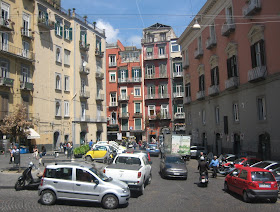Vedi Napoli e poi muori - 'See Naples and die' - is a saying commonly attributed to Goethe, though I have my doubts (I think he actually said, 'Someone who has seen Naples can never be sad.') The famous phrase means, of course, that when you've seen Naples, you can die content, knowing you've seen everything, seen the ultimate. It doesn't mean you'll be mugged by a cut-throat villain, fleeced by a snatch-and-grab kid on a scooter, then expire in the dust, caught in Mafia crossfire. (I'm glad to say none of these things happened to us.) Along with Goethe we found Naples completely wonderful - lively, chaotic, anarchistic, friendly, open-hearted... and real...

You could escape the loud and frenzied streets for quieter backwaters, such as the Piazza del Plebiscito with its Chiesa San Francesco di Paola...

And what about this for a shopping centre! Arndale, please take note...

Here's the Piazza San Domenico Maggiore, in the heart of Naples' historic old quarter, Spaccanapoli. The richly carved Baroque obelisk is called a guglia, and at the top of the steeple is a statue of St Dominic himself...

But how about this? It looks very much like the pensive person (she of the fixed and contemplative gaze) whose back I photographed here in Palermo, and also the photographer I photographed in my Knowing Not-Knowing / Uncontrollable Journey post. And now she's joining me for breakfast in the B&B Parteno on the waterfront overlooking the Gulf of Naples! Whatever next?

Nice to see her looking so happy in Napoli - I found it scary there but your photos show a good side. Hope both of you are well.
ReplyDeleteWhat a delight to travel through Italy being stalked by such a lovely woman! Some men have all the luck.
ReplyDeleteNaples certainly has a bad reputation. good to hear another side...Tramp
ReplyDeleteA lovely portrait of your Joyful Lady of the Midlands!
ReplyDeleteThanks for all your comments!
ReplyDeleteam - we've had enough of sad eyes, and mad eyes, over the past few years - joyful will do for me ...